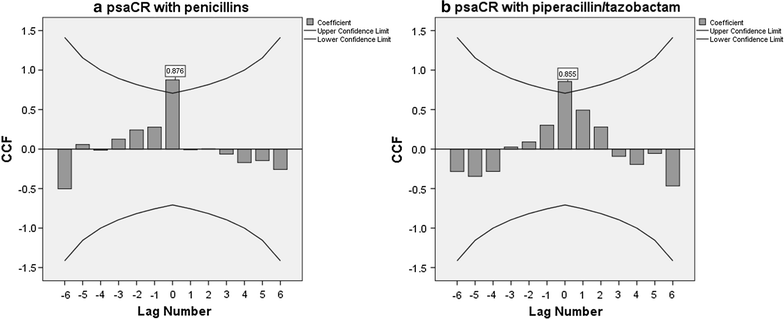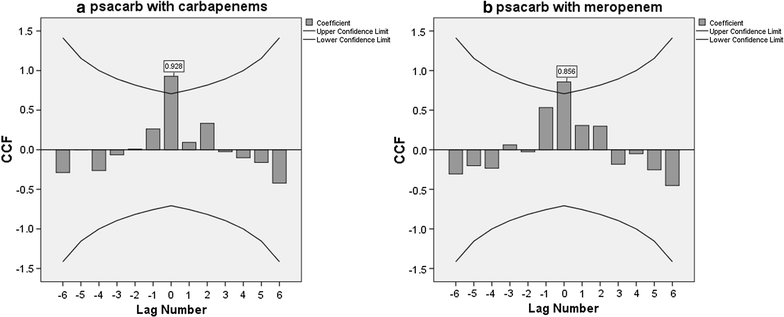Intensive care antibiotic consumption and resistance patterns: a cross-correlation analysis
- PMID: 29132352
- PMCID: PMC5683545
- DOI: 10.1186/s12941-017-0251-8
Intensive care antibiotic consumption and resistance patterns: a cross-correlation analysis
Abstract
Background: Over recent decades, a dramatic increase in infections caused by multidrug-resistant pathogens has been observed worldwide. The aim of the present study was to investigate the relationship between local resistance bacterial patterns and antibiotic consumption in an intensive care unit in a Romanian university hospital.
Methods: A prospective study was conducted between 1st January 2012 and 31st December 2013. Data covering the consumption of antibacterial drugs and the incidence density for the main resistance phenotypes was collected on a monthly basis, and this data was aggregated quarterly. The relationship between the antibiotic consumption and resistance was investigated using cross-correlation, and four regression models were constructed, using the SPSS version 20.0 (IBM, Chicago, IL) and the R version 3.2.3 packages.
Results: During the period studied, the incidence of combined-resistant and carbapenem-resistant P. aeruginosa strains increased significantly [(gradient = 0.78, R2 = 0.707, p = 0.009) (gradient = 0.74, R2 = 0.666, p = 0.013) respectively], mirroring the increase in consumption of β-lactam antibiotics with β-lactamase inhibitors (piperacillin/tazobactam) and carbapenems (meropenem) [(gradient = 10.91, R2 = 0.698, p = 0.010) and (gradient = 14.63, R2 = 0.753, p = 0.005) respectively]. The highest cross-correlation coefficients for zero time lags were found between combined-resistant vs. penicillins consumption and carbapenem-resistant P. aeruginosa strains vs. carbapenems consumption (0.876 and 0.928, respectively). The best model describing the relation between combined-resistant P. aeruginosa strains and penicillins consumption during a given quarter incorporates both the consumption and the incidence of combined-resistant strains in the hospital department during the previous quarter (multiple R2 = 0.953, p = 0.017). The best model for explaining the carbapenem resistance of P. aeruginosa strains based on meropenem consumption during a given quarter proved to be the adjusted model which takes into consideration both previous consumption and incidence density of strains during the previous quarter (Multiple R2 = 0.921, p = 0.037).
Conclusions: The cross-correlation coefficients and the fitted regression models provide additional evidence that resistance during the a given quarter depends not only on the consumption of antibacterial chemotherapeutic drugs in both that quarter and the previous one, but also on the incidence of resistant strains circulating during the previous quarter.
Keywords: Antibiotic consumption; Defined daily dose; ICU; Multidrug resistance; Regression modeling.
Figures


References
MeSH terms
Substances
LinkOut - more resources
Full Text Sources
Other Literature Sources
Medical
Molecular Biology Databases

